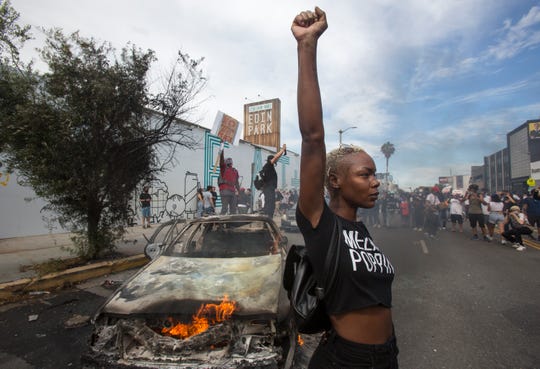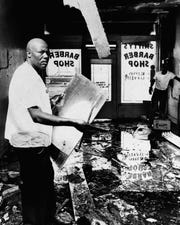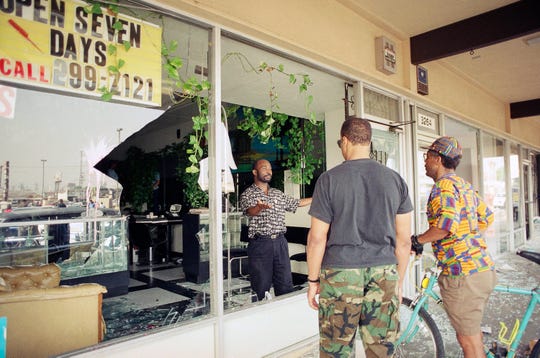Virus, protests reflect white-black economic gap in US
Washington — The United States has been here before, staring into the deep chasm that divides white and black Americans.
It happened after cities burned in 1967, after Los Angeles erupted with the 1992 acquittal of police officers who beat Rodney King, after the 2014 police killing of Michael Brown in Ferguson, Missouri.
After those upheavals came talk of change — of reforming policing, yes, but also of expanding economic opportunity to black Americans who have been disproportionately left behind in one of the world’s richest countries. Yet despite big pledges and high hopes, economic progress has come slowly, if at all, for black America.
African Americans still earn around 60 cents for every $1 in white income. They have 10 cents in wealth for every $1 whites own. They remain more than twice as likely to live in poverty. And they’re about as likely to own a home as they were when Richard Nixon was president.

Now, demonstrators are out in the streets again, this time to protest what happened in Minneapolis to George Floyd, dead after a police officer pressed a knee into his neck for eight minutes and 46 seconds.
Once again, racial inequality underlies rage and despair, especially because the unrest coincides with an economic and health calamity, one that’s falling hardest, yet again, on African Americans.
“We’ve got a perfect storm,” said Cecelia Rouse, professor of economics and public affairs at Princeton University. “COVID is wreaking economic havoc” for African Americans.
Black Americans are far more likely than whites to die of COVID-19. They work disproportionately in low-paying service jobs — the ones that were slashed when restaurants and movie theaters closed as a health precaution and customers stayed away from hotels and airports.
“We’ve been blindsided by the pandemic,” said Imani Fox of the Washington community group ONE DC.
Black workers who remain employed are more likely to work as front-line workers in warehouses, grocery stores and takeout eateries — jobs that leave them exposed to the virus.
“People are mad as hell,” said Monica Lewis-Patrick, president of the community group We the People of Detroit. “We can’t be the wealthiest nation or declare ourselves the wealthiest nation in the world and still have these major inequities and disparities that are glaringly based on race.”
Rouse said she has reread portions of the Kerner Commission report, issued in 1968 to call for reform in the wake of the urban unrest of the late ‘60s. “It was so depressing,” she said. “What has changed?”

A month after the Kerner report, for example, Congress passed the Fair Housing Act, meant to eliminate housing discrimination. Assessing the act on its 50th anniversary two years ago, Margery Turner of the Urban Institute wrote that African Americans and other minorities continued to face discrimination, though the “most blatant” forms of bias had declined.
“We still live in starkly segregated neighborhoods,” she wrote, noting that the typical white Americans lives in a neighborhood that is 75% white and 8% African American; a typical black American lives in a neighborhood that is 35% white and 45% black.
The coronavirus recession is especially disheartening because African Americans finally seemed to be making headway in the aftermath of the Great Recession of 2007-2009. The unemployment rate for black Americans hit a record low last fall. And black wealth, decimated by the financial crisis of the late 2000s, had in recent years outgrown white wealth.
Then came COVID-19.
“When something goes wrong for all American workers, it’s going to disproportionately affect African Americans, who are often the most fragile in the economy,” said Democratic Sen. Cory Booker of New Jersey.
Amid the anger and anguish is optimism that policymakers will use this moment to find ways to narrow the economic gap between black and white Americans. Among the hopes is that political leaders can deliver reforms to America’s economic system: Paid sick leave. A higher federal minimum wage. Perhaps even direct payments to the needy — test-run, perhaps, by the $1,200 stimulus checks the government sent to many Americans as the economy shut down in the face of the pandemic.
But the United States has had watershed moments before. And the big changes didn’t come.
Here’s a look at America’s economic racial divide and how it has and hasn’t changed after decades of protests:
Income
From 1968 to 2018, median income for black households, adjusted for inflation, rose 37% from $30,155 to $41,361. In percentage terms, that outpaced the 31% growth in household income for whites (from $51,138 to $66,943), according to the Census Bureau. But black households still earn just 62 cents for every $1 earned by white households. The disparity was slightly larger in Michigan, 57 cents for every $1, according to the Census Bureau.
The income gap remains wide even though African Americans have vastly upgraded their educational attainment: The proportion of black Americans with a high school diploma has surged from 54% in 1968 to 92% in 2018. The share with a college degree rose from 9% to 23% over that period, according to government figures compiled by the Economic Policy Institute. In Michigan, 25.9% of African Americans have a college degree, compared with 41.6% of whites, according to a 2019 study by The Education Trust.
Yet black people are still more than twice as likely as whites to live in poverty. The white rate has barely budged at around 10%, but blacks’ poverty rate has dropped from 55% in 1959 to 35% in 1968 to 21% in 2018 — 27% in Michigan. The official poverty rate may understate African Americans’ progress because it excludes the effect of non-cash government programs such as food stamps and Medicaid.

Jobs
The unemployment rate for African Americans has typically hovered around twice the rate for whites. But beginning last year, the record-breaking economic expansion that began in June 2009 had finally begun to pay off for African Americans. Their jobless rate dropped from 16.8% in March 2010 to an all-time low of 5.4% in August last year.
That progress ended abruptly once the coronavirus recession wiped out tens of millions of jobs in March and April. Black workers, disproportionately laboring in low-wage service jobs, were less likely to be among the fortunate: The office workers who could keep their jobs while working from the safety of home. African Americans were likelier to either lose their jobs or to work as essential front-line employees who are more vulnerable to the virus.
On Friday, the government issued a surprisingly upbeat jobs report for May: The national unemployment rate unexpectedly dropped from 14.7% to 13.3%. But the jobless rate for African Americans ticked up, from 16.7% to 16.8%, the level where it had been 10 years earlier.
Wealth
Black Americans face an even bigger long-term problem than lagging incomes and higher unemployment. They have struggled to build wealth – home equity and investment portfolios – that could be tapped in times of need, used as collateral for loans to start a business or passed on to children.
“Income helps you pay your bills,” said Olugbenga Ajilore, senior economist at the liberal Center for American Program. “Wealth moves you from poverty to the middle class to the upper class.”
The median black family has wealth of just $17,200 — perhaps enough to buy a car — versus $171,000 for the median white family. The wealth gap persists even for African Americans in the top 10% of U.S. incomes: Their wealth comes to $343,160, less than one-fifth of the $1.79 million for whites in the top 10%, according to government numbers compiled by the Brookings Institution.
One ongoing culprit was the housing bust of the late 2000s. Commerce Department figures compiled by the Urban Institute show that black homeownership rose from 41.8% in 1970 to 47.3% in 2000 before being swept away by the financial crisis and the ensuing recession. As of 2015, black homeownership was 41.2% – lower than it had been 45 years earlier and far below the 71.1% for whites.
In February, researchers at the Brookings Institution reported other reasons for the wealth deficit: African Americans inherit far less money than whites. Even those who become top earners are likelier than whites to fall out of the ranks of the rich. And they are more likely to have to provide financial help to friends and family.
As a Democratic presidential candidate, Sen. Booker pushed a plan for “Baby Bonds’’ to provide $1,000 to every American child at birth. After that, they would receive up to $2,000 a year, depending on their family income. The idea would be to create a nest egg that could eventually be used to finance a college education or buy a home.
Bradley Hardy, a professor in American University’s School of Public Affairs, said that researchers and activists are working on plans like Booker’s to narrow the divide between black and white Americans, between rich and poor.
The current protests could provide momentum for those efforts.
“It’s absolutely an opportunity,” Hardy said. “And, yes, it could be squandered.”
The post Virus, protests reflect white-black economic gap in US appeared first on National Association of Real Estate Brokers.


